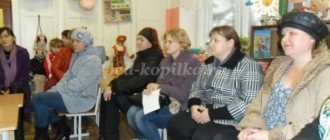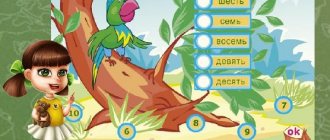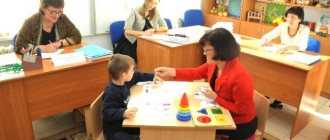Examples
IOM allows you to unlock the potential of each child and teach him to cooperate with the team
Individual routes, as already noted, do not have an established design scheme; they can be in the form of a table or in the form of text - it all depends on the difficulty the development is aimed at solving. Let's consider two drafting options.
Example No. 1
Difficulties: inattentive and absent-minded, has difficulty solving logical problems and mathematical tasks.
Experiences difficulties in solving logical problems and mathematical tasks.
Month Week Regime moments Direct educational activities Independent activity Interaction with parents January 3rd week Working with the multimedia presentation “Count the contour” Game "Tangram" 4 week Walk “Draw a geometric castle in the snow” Tell your friends about your drawing February 1 week Didactic game “What has changed?” Memo "Games for the development of logical thinking" 2 week Duty in a corner of nature Watering plants based on the description of the flower. Multimedia game "Associations" 3 week Working with punched cards “Number Composition” Teach a friend how to work with a card. Game to visit us. 4 week During morning reception, completing tasks on handout sheets Multimedia presentation “Funny Counting” Check your friend's work. Results of the route : The level of development of attention, concentration and switching has increased. The child copes with tasks of a mathematical nature and logical problems.
Example No. 2
Child's age: 4 years 2 months
Gender: male
Problem: Poor computing skills
The purpose of the individual route: development and consolidation of computing skills within the top ten
Objective: to develop attention, memory, logical thinking.
Frequency of classes: 2 times a week
Duration: 20 minutes
Exercises in class:
- “The numbers got lost” Put the numbers in order Learn to name the numbers in order
2.”What has changed? What number is missing? Name the next and previous digit of the natural series Play the game “Name your neighbor”
3. “Fun little engine” Attach and attach the carriages with numbers to the engine. Solve examples by adding the number 1.
- Put cars in the garage Solving examples by counting units Learn to name the next and previous digit
- “Postman” Deliver letters - examples to houses (solving examples by adding and subtracting numbers 1 and 2) Play the game “Bring a letter to your grandmother, brother”
- “Paratroopers” Each “paratrooper” is given a number based on your own example. Games at home to count objects that surround the child.
- Help Dunno solve examples Solve examples of the top ten using punched cards Solve examples using fairy-tale characters: Piggy, Stepashka, Cheburashka, etc.
- Let's help the hedgehog collect mushrooms. Consolidating computing skills within the top ten. Solving examples at home.
Structure of an individual lesson:
- Organizational moment: a moment of joy.
- A surprise moment: the arrival of a fairy-tale character.
- Main job: help, guess, advise
- work at a magnetic board;
— exercises with handouts;
- work in a notebook.
- Result of the lesson: a minute of communication, what you liked, what caused difficulties, and what was difficult.
Performance evaluation:
As a result of systematic and systematic work with a child who has weak computational skills, by the end of the one-year cycle of classes: computational skills will be strengthened; cognitive interest in mathematics will increase; The child’s mental activity is activated, he will freely perform computational exercises within the first ten. These achievements will help in the future to overcome problems in the mathematical development of preschoolers.
Natalia Sertakova
https://www.maam.ru/detskijsad/individualnyi-obrazovatelnyi-marshrut-na-vospitanika.html
An individual educational route is an effective way to find an approach to each child, to interest him in the learning process or to solve problems of socialization and communication difficulties. With the help of IOM, you can also organize work with gifted children. In subsequent education, the child will be more organized, but, most importantly, he will have the opportunity to choose the activity in which he feels most competent.
IOM tasks, review and approval procedure
Individual educational routes are designed:
- for problem children who experience difficulties in the process of mastering the general education program for preschoolers and need correctional assistance from specialists;
- for pupils with disabilities, disabled children;
- for gifted children with a level of ability exceeding average regulatory educational standards.
The purpose of the individual educational route is to solve the problem of accessibility of preschool institutions for children with disabilities
Leading tasks of an individual educational route:
- provide support and assistance in self-development and mastering the preschool education program;
- to form in the child an initial level of learning ability, i.e. teach him to understand the educational task, plan his educational activities, concentrate on completing the exercise, develop self-discipline and volitional qualities;
- develop and improve movement coordination skills, development of gross and fine motor skills;
- to form and consolidate general cultural, everyday, hygienic, communicative foundations of behavior;
- to accustom the child to manipulative-objective, sensory, practical, play activities, to develop skills in the productive area (drawing, modeling, appliqué);
- develop speech - emotional intonation, grammatical structures, speech mechanisms;
- to generate knowledge about the natural environment and the world of social relations;
- form ideas about spatio-temporal and quantitative categories.
Methodological tools that are used in the passage of an individual development trajectory:
- role-playing and outdoor games, classes in the form of conversation and dialogue, reading and discussion of literary works, small improvisation sketches that enhance the emotional component of information perception;
- psychological trainings and game exercises that help relaxation, neutralize fears, reduce anxiety and aggression, improve behavioral sphere, as well as social and communication skills;
- exercises to develop thinking, imagination, speech, memory;
- use of art therapy techniques (treatment with art, fairy tales, doll making).
Individual attitude and an integrated approach to the problem of development are the key to success even in the most difficult situation!
Development and adoption of the IOM
To create an individual educational route, it is first necessary to conduct a diagnostic study to find out the level of psycho-emotional, intellectual, communicative, social and physical development of the child. The diagnostic results are presented to the teachers' council, which subsequently recommends that the children be examined by specialists from the PMPK (psychological, medical and pedagogical council).
Sample for the conclusion and recommendations of the PMPC
| FULL NAME. child |
| Date of Birth |
| Family information: Mother (full name, education, place of work) |
| Father (full name, education, place of work) |
| Teachers (full name): |
| Specialists: Speech therapist teacher: Speech pathologist teacher: Educational psychologist: Music director: Senior nurse: |
| Health group |
| Regime of a child’s stay in a preschool educational institution |
| Conclusion of the PMPC |
| PMPC recommendations |
| Long term goals |
| Goals for the current period (academic year) |
The council compiles a list of children for whom the development of an individual educational work plan is relevant.







